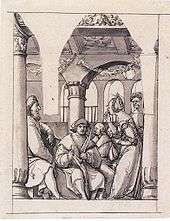Leaena
Leaina (Greek: Λέαινα, "lioness") is a pseudo-historical figure, supposedly a hetaera and, according to a later tradition,[1] the mistress of Aristogeiton the Tyrannicide.[2] Original versions of the story of Aristogeiton portray him, on the contrary, as the lover of Harmodius, for whom he decided to overthrow the tyrant Hipparchus. Hipparchus had feelings for Harmodius, and he tried to humiliate him after his feelings were rejected.[3]

In 514 B.C., Harmodius and Aristogeiton, a male couple, were inspired to overthrow the tyranny of Hippias and Hipparchus at Athens.
Hipparchus was murdered, but Hippias escaped, and seized the surviving conspirators. According to later versions of the story, told among others by Plutarch, among those captured was the hetaera Leaina, lover of Aristogeiton, or Harmodius, or both. Leaina was tortured to get information about the conspiracy.[4]
According to Pausanias, the Athenians later set up a statue of a bronze lioness on the Acropolis in her memory: "When Hipparchus died, Hippias tortured Leaena to death, because he knew she was the mistress of Aristogeiton, and therefore could not possibly, he held, be in ignorance of the plot. As a recompense, when the tyranny of the Peisistratidae was at an end, the Athenians put up a bronze lioness in memory of the woman, which they say Callias dedicated and Calamis made."[5]
Leaina was commemorated on account of her stubborn resolve under the torture of the tyrant. Athenaeus (who believed Leaina's lover was Harmodius) says: "There was also a courtesan named Leaena, whose name is very celebrated, and she was the mistress of Harmodius, who slew the tyrant. And she, being tortured by command of Hippias the tyrant, died under the torture without having said a word." [6]
According to Jerome, Leaina rose to the occasion even further; to preserve her silence, and to frustrate her torturers, she bit her tongue off, and so died: "Harmodius and Aristogiton killed the tyrant Hipparchus, and the courtesan Leaena their friend, when compelled with torments, lest she betray her companions, she amputated her tongue with her teeth." [7]
Therefore, the brass lioness statue at the entrance to the Acropolis was without a tongue: "And Leaena also has a splendid reward for her self-control. She was a courtesan belonging to the group led by Harmodius and Aristogeiton and shared in the conspiracy against the tyrants — with her hopes, all a woman could do; for she also had joined in the revels about that noble mixing-bowl of Eros and through the god had been initiated into the secrets which might not be revealed. When, therefore, the conspirators failed and were put to death, she was questioned and commanded to reveal those who still escaped detection; but she would not do so and continued steadfast, proving that those men had experienced a passion not unworthy of themselves in loving a woman like her. And the Athenians caused a bronze lioness without a tongue to be made and set up in the gates of the Acropolis, representing by the spirited courage of the animal Leaena's invincible character, and by its tonguelessness her power of silence in keeping a holy secret. "[8]
The statue was not made by Calamis but by the Athenian sculptor Amphicrates, according to Pliny.[9]
It is possible that Leaena's story, replacing the account of Harmodius and Aristogeiton as a couple, was invented to explain the existence of the lioness statue with the missing tongue, or perhaps to accommodate the homophobia of writers from late antiquity.[10]
See also
Notes
- Konstantinos Kapparis (2018). Prostitution in the Ancient Greek World. De Gruyter. p. 99. ISBN 978-3110556759.
The noble tale of homosexual love and honor, as told by Thucydides, is refashioned into a story of endurance and self-sacrifice centered around the hetaira Leaina.
- Polyaenus, Stratagems, 8.45
- Thucydides, History of the Peloponnesian War, 6.54.
- Edward Bulwer-Lytton, Athens: Its Rise and Fall, Volume I, Book II, Chapter III, Section III
- Pausanias 1.23.1–2.
- Athenaeus, Deipnosophists, 13.596.f
- Beginning of the Consuls of the Romans
- Plutarch, On Talkativeness, Moralia 505.E
- Entry Amphicrates Archived 2012-10-12 at the Wayback Machine at the Dictionary of Greek and Roman Biography and Mythology
- Kapparis (2018), p. 100–101. "This story is a revision of the traditional tale in order to explain the bronze lioness with the missing tongue, and probably also to gloss over the uncomfortable feeling of later antiquity audiences over the homosexual relationship of those two most glorious heroes from the Athenian past."
References
Primary sources
- Pliny the Elder, Natural History VII.23.87, XXXIV.19.72
- Eusebius, Chronicon 106.1-7
- Plutarch, Moralia On Talkativeness 505E
- Polyaenus, Stratagems 8.45
Secondary sources
- Plutarch, The Morals, volume 4, trans. William W. Goodwin w/ Introduction by Ralph Waldo Emerson, (Boston: Little, Brown, and Co., 1878) The Online Library of Liberty
- The Reign of the Phallus: Sexual Politics in Ancient Athens By Eva C. Keuls, p. 194, University of California Press (1993), ISBN 0-520-07929-9
- Athens: Its Rise and Fall, Volume I, Book II, Chapter III, Section III, by Baron Edward Bulwer Lytton Project Guttenberg
- Eusebius, Chronicon, ed R. Helm (Leipzig, Germany 1913), 106.1-7
External links
